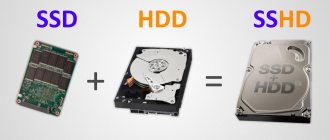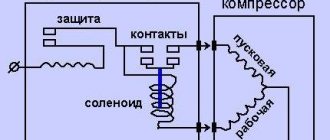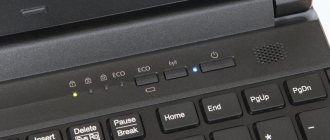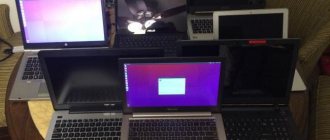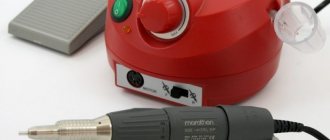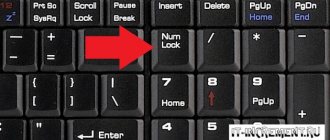Using the Boot Menu
To begin with, we will tell you about the simplest way to solve the problem, gradually moving on to more complex techniques. When the power button stops working, it is best to take the laptop to a service center for repairs. If you urgently need to start your computer, then use the Boot Menu
. The main purpose of the menu is to select the operating system boot device. The user can install the file on the hard drive, external drive or disk.
Inspect the laptop case. In addition to the main power button, there may be a small additional button to launch the BIOS. It is intended for emergency situations, such as, for example, a non-functional starting mechanism for a laptop computer. Most often it is located with the power connector (the connector for connecting the charger cord) or directly next to the Power
. Again, depending on the model of the device, the method of pressing it also depends, but, as a rule, a pencil or pen is used for this purpose. On Acer models it is often located here.
On Lenovo, on the side or on top, under the keyboard; in different models, the location of the emergency power button may be different.
It should be said right away that it is not available on Samsung and Dell.
When you find an emergency BIOS settings switch on the case, of course, you need to press it. Then wait until the laptop turns on and starts the settings. The further procedure is just as simple: in the blue window that loads, you need to select Normal Startup
and press the Enter key on your keyboard.
After this, the operating system will boot in normal mode. True, it will be inconvenient to use this technique every time. If you cannot quickly repair your laptop, set Windows to go to sleep.
How to turn on a laptop without the power button [using the keyboard]
For this process, you will need to change some settings in the BIOS. If your system is already turned on and fully operational, follow these steps:
Enter Settings in the Start menu >> Update & security >> in the options on the left, select Recovery >> in the tab that opens, select Advanced setup >> Restart now >> in the window that opens, select Troubleshoot >> Advanced options >> Power management or ACPI management >> press Enter >> look for Keyboard Wake or Keyboard Wake >> Press the (+) or (-) buttons to enable or disable the option >> select the key you want to use to power the laptop. >> Save and Exit .
Read also: Best Cheap Laptops for High School Students
If you followed the instructions, and if the settings are supported by your laptop, you should now be able to turn it on using the key you selected after shutting down the system.
Related: How to turn on a laptop without the power button how to turn on a laptop using the keyboard how to turn on a laptop without opening the lid how to turn on a dell laptop without pressing the power button starting a computer without the power button how to turn on an hp laptop without pressing the power button how to turn on a laptop without pressing the power button lenovo how turn on laptop motherboard without power button
Setting up sleep mode
You will need to enable the ability to activate sleep mode if it was previously deactivated. This mode is designed to maximize energy savings. It is especially useful if you have to be away from your laptop for a long time, but you don’t want to turn it off or simply forget to do so.
First of all, look carefully at the designations of the laptop keyboard keys. You can find a crescent moon symbol, which indicates the ability to activate sleep mode by pressing this very button.
To exit the mode, just press one of the keys or click the computer mouse button. To configure automatic activation of the mode, go to the Windows Control Panel, then the “ Power Options”
" and "
Changing scheme parameters
".
Next, we set the time period after which the laptop will go into sleep mode. If the device is running on network power, then instead of “ Never
» set a specific time. Finally, do not forget to save your settings.
How to turn on a laptop without a power button [with a wall socket or extension cord]
If you are using a Dell, HP, ASUS, Lenovo, Acer or even Toshiba laptop, this is one of the options that you can try. This is a great solution for users who don't want to short-circuit their laptop to turn it on.
Find the cable connecting the power button to the motherboard >> unplug and leave this cable unplugged >> now remove the battery from the laptop and plug the laptop into the outlet >> this should turn it on >> if the laptop is on, put the battery back in the laptop, unplug it from the outlet , if you choose , and everything will be fine.
Note. On some laptops, you may need to enter the BIOS to configure the laptop to turn on when AC power is detected.
Closing contacts on the motherboard
Now a difficult way to solve the problem is to close the contacts of the power key. The Power mechanism is designed to close contacts that transmit an impulse to turn on the computer. This means that when the button does not function for any reason, you can close the contacts yourself. To do this, you will need any conductive object, such as a screwdriver.
You take further actions at your own peril and risk. If the laptop is under warranty, of course, there is no need to disassemble it and try to fix it yourself. Immediately go to the store where you purchased it to resolve the problem. Similar actions can be taken by owners of older devices whose warranty period has long expired. But even in this case, there is a small nuance: careless actions can easily damage expensive boards and aggravate the breakdown. The cost of subsequent repairs will be many times greater than replacing one faulty Power button.
If you are confident in your own abilities, then the procedure is as follows:
- Disconnect the laptop from the network;
- We take out the battery and disassemble the case;
- We remove the bottom panel: unscrew all the bolts, if necessary, use a plastic card to pry up the joint of the parts, and then draw around the perimeter;
- Unsnap all the latches;
- We find a connector on the motherboard to which the power button is connected via a cable;
- Now you need to determine a pair of contacts PWR and Ground (case), when closed, the device will turn on. This will most likely have to be done experimentally, because... There are a huge variety of motherboards for laptops, and finding a circuit diagram for a specific model can be problematic.
Video instruction
How to turn on a laptop without the power button [from the motherboard]
- Open the laptop case and find the port where the power button ribbon cable is connected >> now you should disable the power button .
- Get a small one and short the 1st and 3rd pins in the power button port . If this doesn't work with your laptop, you can short all the pins at once. It won't hurt , so don't worry. If you short the circuit correctly, the laptop should start in no time.
Now, opening your laptop every time or shorting it every time can cause long-term hardware problems, especially if it's a computer you're not ready to give up on, so for now, before you fix the power button, there are other ways to safely start your computer without a button nutrition.
Closing the button contacts
Perhaps the next method will be simpler. You can close the contacts not only on the motherboard connector, but also on the power button itself, even if it does not work.
Moreover, this is easy to do on models in which to access the power button you just need to remove the cover on the front panel above the keyboard.
The work is also not easy, but somewhat easier than disassembling the laptop to its core.
If the laptop does not react in any way to closing the contacts, most likely the problem lies elsewhere. Be sure to check the battery. She could have discharged. Check the power cable as well as the unit itself. You can never rule out the possibility of failure of the motherboard or processor. If there is a power surge in the network, after which the laptop stops turning on from the button, you should contact the service center so as not to waste time.
Turn on Wi-Fi using keys or a button on the case
There are two simple options for turning on WiFi, which you can use if you find that there is no wireless connection on your laptop, and therefore the Internet will not work. The first launches the Wi-Fi module using a key combination, and the second thanks to the button located on the case. Let's look at these methods in more detail.
We activate Wi-Fi with the button on the case
There are laptops in which the manufacturer builds a separate Wi-Fi button for convenience. But on older models there may be a small slider instead of a button. Therefore, you have to carefully inspect the entire case for the presence of a button or slider. If you find it, try turning on Wi-Fi, and if not, then read the second option below.
The laptop does not turn on from the power button - repair overview
An incomprehensible situation when, when you press the power button, the laptop does not show any signs of life, makes the user seriously nervous.
The laptop is often used for work, so one involuntarily becomes afraid for the fate of the documents stored on it. Fortunately, these fears are not always justified: in most cases, any problem with a laptop computer, be it hardware problems or software glitches, can be fixed without causing data damage. Moreover, you can diagnose and fix this malfunction yourself.
As practice shows, there may be several reasons why the power button stops starting the laptop . All of them can be divided into two groups - hardware (problems with hardware) and software. Let's look at the most common of them:
PC power failures are the most common hardware problem. It is possible that the laptop battery is completely discharged, and to fix the problem, just put the laptop on charge and wait a little.
- When connecting the power supply, you should pay attention to whether the power indicator, which is usually located on the front of the laptop case, lights up. If the light does not light, then the reason should be sought in the adapter and power cords.
- In this case, you need to check the reliability of the connections of all connectors and make sure that the outlet itself is working. To do this, just connect any other working electrical appliance to it. Next, you should inspect the power cord for damage.
- If the laptop's power button is blinking, this indicates problems in the power circuit. There is a possibility that there is a problem with the internal power supply on the motherboard. In this case, you cannot do without the help of a specialist.
- Battery problems. If the power light is on, but the laptop does not respond to the power button, you should check the battery. To do this, you need to remove the battery, pause for a few minutes and try to start the computer without it. If the problem was in the battery, the laptop will turn on, but will only work from the mains. In this case, all that remains is to purchase a new battery.
Lack of initialization is the main reason of a programmatic nature.
In this case, when you click on the “Start” button, the laptop starts, but does not fully boot. There may be several reasons for this behavior.
The most common are damage to the BIOS firmware, overheating of the processor (for example, due to a cooler clogged with dust), the hard drive cannot boot, etc.
Some missing initialization problems can be resolved on your own.
- First, you should disconnect the hard drive and check whether the BIOS splash screen appears when you turn on the laptop. If it appears, it means the hard drive requires repair or replacement.
- You should also check whether the RAM is tightly seated in the connector (it often comes off due to shock or vibration).
The power button does not work.
- The start button of the laptop itself may also fail during operation. There may be several reasons for this - from simple wear and tear and contamination to moisture getting on the conductive paths (for example, when turning on the computer with wet hands).
- To fix the problem in this case, you should check the functionality of the button and, if necessary, clean or replace it.



